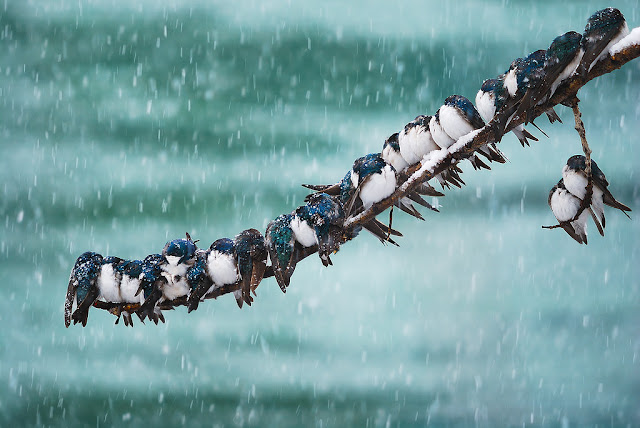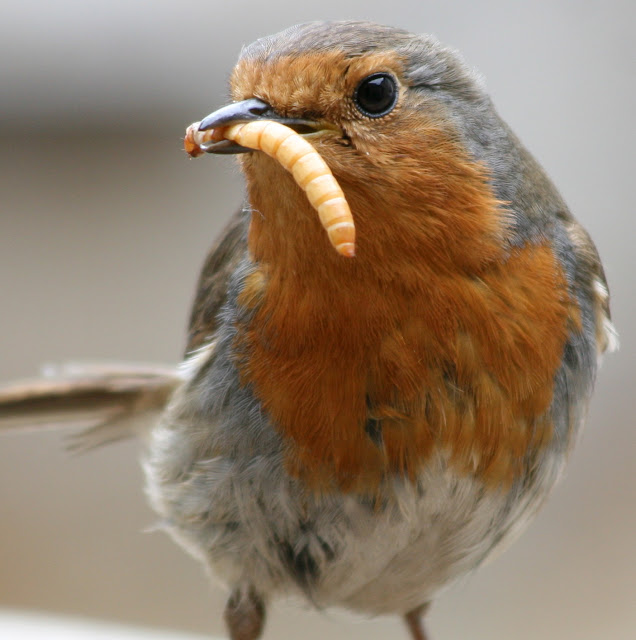Why don't birds' feet freeze in the winter
Winter is a harsh reality for wildlife living in our communities. Many of these animals have to spend their days out on the ice and snow looking for food. For example, take Canada geese. They are an easy sight at local lakes and ponds, frozen or not. How does this happen?
Birds are warm-blooded, just like humans and other mammals. According to the Audubon Society, their body temperature is constant at 106 degrees. Their bodies have several mechanisms to keep their bodies warm in cold temperatures.
It is vital for waterfowl, including ducks, that their feet and legs are warm in order to survive on ice and cold water. This is why these animals depend on a vascular system that was designed for them. These birds have close-knit arteries and veins that run through their legs and feet. This allows blood to heat and cool quickly, according to the Smithsonian report.
Warm, oxygenated blood moves toward the feet of the bird as it leaves the heart via arteries. It then passes close to veins that return oxygenated blood to the heart. This allows for heat exchange. This allows for the heat exchange to occur, where the heat from the arterial blood can increase the temperature in the blood returning to the veins. The blood is then colder when it reaches the bird's extremities. Popular Science reports.
This heat exchange doesn't only benefit birds. This heat exchange is also used by squirrels and other mammals who spend time in snow. Popular Science says that the science behind this is similar to how fish use oxygen in their gills.
Birds stay warm in winter by using heat exchange. According to the Audubon Society, many birds have a winter plumage that has more feathers in order to insulate themselves better. Finches are one example of a species that add fat to winter in order to provide energy and insulation.
However, many small birds can't gain too much weight as it could affect their ability to fly. These birds, like chickadees and budgies, need to shiver in order to stay warm. Birds don't shiver as much as humans. Birds can activate certain muscle groups when they shiver. According to the Audubon Society this causes muscle contractions which allow birds to retain heat better.
How do birds cope with winter cold?
Birds have many ways to keep warm in low temperatures, including fat and feathers.
While many birds make epic journeys to warmer environments each autumn, some species remain put for the winter. These winter birds are more likely to maintain their territory all year round and avoid the dangers of migration. They had to put up with the cold.
Birds are warm-blooded like us. Their bodies keep a constant temperature of around 106 degrees Fahrenheit. They have many strategies to generate heat and keep it going, some of which are similar to ours.
To avoid the elements, sparrows seek shelter in dense leaves or cavities. Huddle together to share warmth and tuck in their feet. Cardinals are hard to miss in the snow and smaller birds puff up to look like a small beach ball to reduce heat loss.
David Swanson, University of South Dakota physiologist, says that big birds like geese or grouse do the same thing as us. Insulation was installed." Adding an extra set of downy feathers is a common way to add insulation.
Birds can gain fat to both insulate and as an energy source. Some species, such as chickadees or finches, may have more than 10% of their winter body weight. Some birds spend a lot of their day searching for fat food sources. This makes feeder food more valuable to survive a frosty night.
Swanson responds to the question about which birds are the most resilient winter survivors by pointing out little chickadees. These tiny creatures are unable to put on too much weight for aerodynamic reasons. Swanson explains that they are skilled at shivering. This isn’t the usual tremble mammals use to generate heat. Birds shiver when they activate opposing muscle groups. This creates muscle contractions, without the typical jiggling that humans do when they shiver. This type of shaking is more effective at conserving heat.
Many species share another adaptation: the ability to maintain warm blood circulation near vital organs and allow extremities to cool off. Gulls are an example. Gulls can stand on ice at temperatures near freezing with their feet while keeping their core warm.
It is easy to stay warm when the sun shines, but winter is a different story. Nightfall is when temperatures drop, and birds need every survival mechanism they can find. Birds can save energy by allowing the temperature inside to drop. Famous examples of this are the Hummingbirds, who go into torpor when their body temperature drops to near outside. Torpor isn't common among winter birds because it would require too much energy to warm up in the morning. Black-capped chickadees, and other species, experience a milder version of this. They can reduce their body temperature by up to 22 degrees Fahrenheit, which is known as regulated hypothermia.
Hanging feeders is an easy way to keep birds safe in harsh weather conditions. You can attract many birds by using different feeder styles and different foods. For example, a tube feeder with black oil sunflowers or mixed seeds will attract chickadees. Suet feeders are a favorite food of woodpeckers. A feeder that is filled with sunflowers or safflowers attracts both the regular visitors and larger birds such as red-winged blackbirds and cardinals. For more information, see the Audubon Guide for Winter Bird-Feeding. You'll be able to see many species flocking to your feeders and plants from your backyard buffet.
How do birds keep warm in cold temperatures?
Many birders are amazed at the variety of winterbirds that visit feeders on cold days. They may also wonder, "Do birds get cold?" Wondering how wild birds can survive in cold conditions? Birds have amazing adaptations. If birders understand the needs of birds to stay warm, they can help their feathered friends.
Bird Body Temperatures
Birds are warm-blooded animals with a higher metabolic rate and therefore a higher body temperature than humans. The average bird's body temperature (40° Celsius) is 105 degrees Fahrenheit, although the exact measurement can vary between species. The bird's body temperature can vary depending on weather, diet and activity. However, it can be difficult for birds to keep such high body temperatures when temperatures drop. Because they have more heat to lose than their core volume, smaller birds are at greater risk. Even small birds can keep warm in extreme cold by using several methods.
How Cold Birds Keep Warm
Birds can use many behavioral and physical adaptations to stay warm no matter what the temperature outside.
Physical adaptations
- Feathers: The feathers of birds provide incredible insulation against the coldMany bird speciesAs part of a regrowth program, you can grow more feathers.Late fall moltTo provide them with thicker winter protection. Oil that coats the feathers of birds from theUropygial glandIt also offers waterproofing and insulation.
- Feet and LegsSpecially designed scales are applied to the feet and legs of birds to reduce heat loss. Birds can regulate the temperature of their feet and legs separately from their bodies. This is done by restricting blood flow to their extremities.
- Fat ReservesEven small birds can accumulate fat reserves that serve as insulation and additional energy to generate body heat. When food is plentiful, many birds will gobble up fall fruits to build up fat reserves that they can use for insulation and extra energy.
Behavioral adaptations
- Fluffing: To insulate against cold temperatures, birds fluff their feathers. This can help them to be more comfortable.Look fat and puffyWhile they are still warm.
- TuckingBirds can also cover their legs with feathers, protecting the skin from the cold. Birds can also tuck the feathers under their legs.BillsTo protect themselves and allow them to inhale the warm air from their bodies, they can place their shoulder feathers into their lungs.
- SunningMany birds are attracted to sunny winter days.Solar heat: Take advantage. They will face the sun, exposing their largest surface to the heat. This allows the sun's heat to penetrate their skin and feathers better. Sunning can also allow the wings to be spread or drooped, while the tail may be spread. The faster birds heat up, the more surface area they can expose to sunlight.
- ShiveringBirds shiver in order to increase their metabolism and produce more heat, which is a temporary solution to extreme cold. Shivering is a good way to keep warm in extreme temperatures, even though it requires more calories.
- RoostingSeveral small birds such as bluebirds and chickadees gather together at night in large numbers to share their body heat. They will roost in trees and shrubbery, or empty birdhouses.Bird roost boxesThese are great places to save heat. Individual birds may choose to roost in areas that retain heat from the sun, such as near the trunk of trees or any other dark surface.
Fun Fact
Emperor penguins are one of the most resilient birds. They keep warm in cold temperatures by snuggling together in large groups.
Torpor
To conserve energy in the winter, many birds will go into Torpor. When the body temperature drops, it causes a reduction in metabolism. Therefore, the body requires fewer calories to keep warm. While most birds can reduce their body temperature by a few degrees in a normal environment, some birds that are too hot can drop their body temperature as high as 50 degrees. However, torpor can prove dangerous as it slows down reactions and makes birds more vulnerable to predators. Hummingbirds and chickadees use torpor to stay warm in cold weather.
Helping birds stay warm
Despite all the adaptations made to keep birds warm and heat, some birds still die from cold temperatures. This can happen during extreme winters and sudden cold snaps. If birders know how to keep wild birds warm during winter, they can give their flocks an advantage over the worst weather.
- Offer good food: Offers theBest winter bird foodThis includes selecting seeds, nuts, and suet.Peanut butterScraps and other high-fat foods are good options for birds to get more heat.
- Keep Feeders FullBirds need to have easy access to food after a long and cold night. So birds can find high-energy meals, no matter the weather, by keeping their feeders stocked with nutritious seed.
- Offer Liquid WaterIf necessary, birds can melt snow to drink but it will lower their body temperature. This will also use valuable energy to keep them warm. If birds are able to drink from a vessel,Heated bird bathEven in freezing temperatures, they have a better chance of survival.
- Shelter: PlantEvergreen shrubsAndConiferous treesThis will provide shelter for the winter orBuild a brush pileTo provide birds with a safe and secure place to rest. You can also place shelter near windbreaks to provide additional protection.
It's not necessary to worry about birds staying warm when temperatures drop. Birds have many efficient adaptations that can withstand even the coldest nights. Birders who are able to understand these adaptations and provide shelter and food for birds will ensure that they have warm, healthy birds.



Comments
Post a Comment